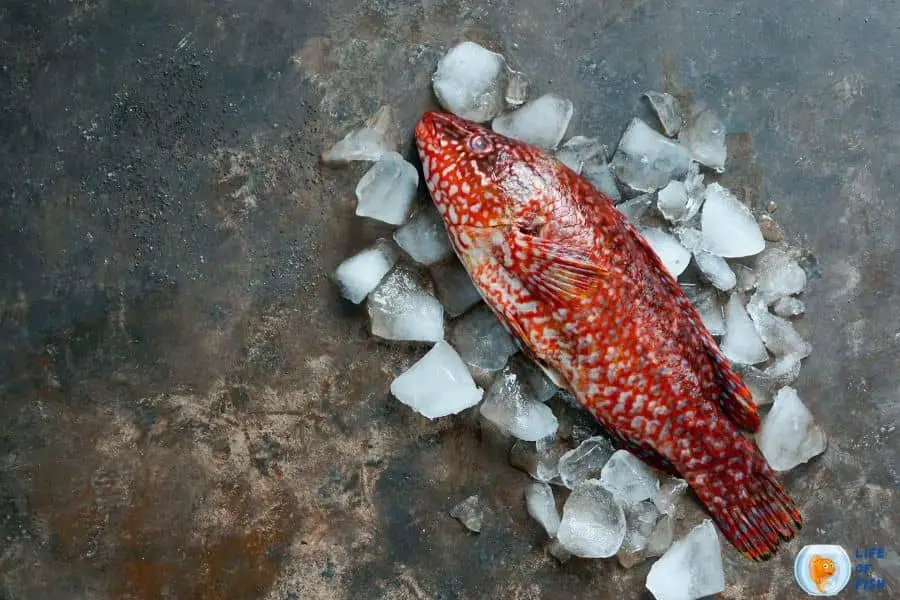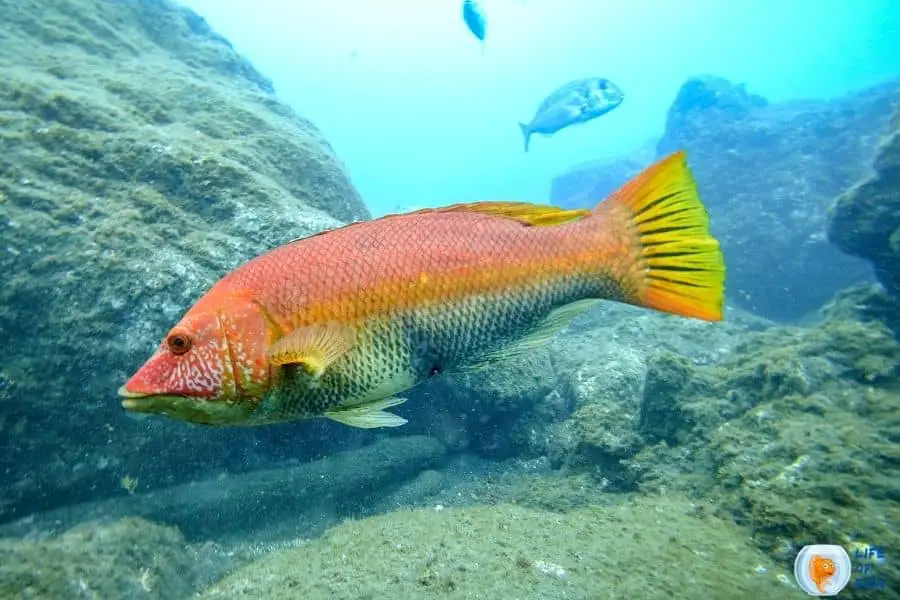Ballan wrasse is a species seen in aquaculture fields and the aquarium trade. They are beautiful, valuable as cleaner fish, and are also regarded as food fish.
A large-sized fish with a long life span, Ballan wrasse, is a colorful fish that is interesting and easy to maintain. But, they are not popular as pet fish because of their size. This article will provide information about this wrasse species, its scientific name, alternative names, characteristics, food habits, and other information.

Want to learn about the fascinating behavior and habitats of wrasse fish? Dive into our comprehensive guide! – wrasse fish
What is Ballan wrasse
Jump To
Ballan wrasse (Labrus bergylta) is a species of wrasse found in the Eastern Atlantic Ocean from the South of England to Senegal and along the West African coast. In some regions, they can be found as far north as Norway. There are records of finding these fish in the Mediterranean, Adriatic, and Marmara seas, but their existence in these areas is doubtful.
This is the largest wrasse species found in UK waters. This species of wrasse can be seen at depths of 3 to 164 feet (1 to 50 meters). Adult specimens usually stay among rocks, corals, and seaweeds. They can be found singly or in small groups. The juveniles typically stay in intertidal areas.
How Ballan wrasse looks like
Color
Adult fish can vary in color. Some specimens are dark green with white spots white, and some others reddish-brown with white spots all over the body. There can also be a mixture of green and reddish-brown colors. Young fish are bluish-purple with yellow or brown spots.
- Size
The average size of full-grown fish is around 50 cm (20 in), but the maximum length recorded was 65.9 cm (25.9 in). The heaviest Ballan wrasse recorded was 4.4 kg (9.7 lb).
- Shape
They have a relatively deep body with large head. The mouth is small and is surrounded by thick, fleshy, and wrinkled lips. The body is covered with scales, and it also has two long, slender, and tapering (strait) dorsal fins. The caudal fin (tail) is large, and it’s usually squared. Tips of the pectoral fins of these fish are pointed. It has a single row of scales in front of the gills.
- Life span
They are reported to live about 29 years maximum.
- Male and female fish
All Ballan wrasse are born females and remain as female in their first four to 14 years. Then the dominant female becomes the male, which means they are protogynous hermaphrodites. Because male fish are generally larger, almost all large fish will likely be male. Otherwise, there is no difference in coloration or body shape between the sexes.
Where Ballan wrasse live
They can be found among rocks, seaweed, and reefs at depths of 1 to 50 m (3.3 to 164 feet). They are distributed around the eastern Atlantic from the South of Ireland to Senegal, and they can also be found along the West African coast. But their existence in the Mediterranean, Adriatic, and Marmara seas is doubtful. The water temperature where they live vary between 0 to 20 °C (32 to 68 °F), and they can tolerate a wide range of pH from 7.0 to 8.5.
These fish thrive in warmer water and struggle in cooler water. Therefore, they tend to swim down the deeper waters about 200m deep during the winter months. After migrating into deeper waters, they hibernate during winter.
Their behavior
These fish prefer to live in vegetated areas as they can easily find food and camouflage, which helps them to avoid predators. This species of wrasse is a diurnal species, so they usually feed during the day and rest at night.
Younger fish usually stay in intertidal areas, and adults tend to move into deeper waters. However, they usually swim into shallow water to prey on shellfish found among rocks. Their mouths are adapted to extract shellfish from rocks. They have strong pharyngeal teeth, which they use to remove the flesh from the shells of mussels and other crustaceans.
Juveniles grow very slowly, so they have to remain in intertidal areas to feed on isopods and amphipods. They also feed on crabs, shrimp, and small fish. These fish go into deeper waters of about 200 meters deep in the winter months to hibernate. They can not survive in waters below 2 degrees Celsius.

What do Ballan wrasse eat?
They are carnivore fish, and their main diet is made out of sea urchins, crabs, and other crustaceans. They can also feed on a wide variety of fish, shrimps, mollusks, cephalopods, echinoderms, and worms.
Their diet mainly consists of hard-shelled crabs, small lobsters, and shellfish as their mouths are adapted to feed on hard-shelled species. They also eat parasites from other fish. So, they are also popular as cleaner fish.
Ballan wrasse breeding
Ballan wrasses are egg layers, and they are known as good parents. The male fish builds a nest in a crevice with algae, and the female lays eggs there. Then male fish guards the eggs and take care of them until they hatch. The eggs of these fish hatch within about a week, and the larvae are pelagic, meaning that they live in the water column. After another week, the larvae sink to the bottom and start searching for food.
Importance of Ballan wrasse
- Ecosystem balance
They are important species for their ecosystem because they help balance the population of echinoderms (i.e. urchins), crabs, mussels, and other mollusks. So if there is no Ballan wrasse in their habitat, this will cause an overpopulated species of mollusks.
They are also good cleaner fish that eat parasites of other fish. This will help the fish population live healthily and help keep the ecosystem in balance. They are prey for many fish and birds, so they help to keep the food chain in balance.
- As a food
These fish are very popular for their delicate taste in the Orkney Islands in Scotland and Galway (a country in the west of Ireland). However, they are not popular as food fish in the UK and Ireland.
- Sportfishing
They have become popular as game fish in recent years. They are a popular catch and release target among sport fishers and are considered good sport fish.
- Aquarium trade
This fish is also popular in saltwater aquariums, so they are commercially important for this reason. However, they are not popular in the home aquaria due to their size. They are often seen in public aquaria.
- Other uses
They are popular in Norwegia in aquaculture. Norwegians use these fish to remove fish lice from farmed Salman fish in Norwegia. The approach is also being studied in Scotland.
How do you catch a Ballan wrasse?
They are among the preferable gamefish in all wrasse species in the UK because it is the largest wrasse species in the UK waters. You can catch them by bait fishing. For bait, you can use several blennies, shrimps, crabs, or prawns. They are easy to catch because they are not very suspicious of predators.
It’s more likely that when you catch one Ballan wrasse, you will catch more from the same place. However, we recommend avoiding this practice as much as possible and releasing the fish alive to save the species. Most large Ballan wrasses live in more rugged and inaccessible rocks and cliffs but beware of the dangerous undercuts in these areas.
They are not very suspicious of a predator. So, you can catch them with almost any type of fishing rod. They are usually caught in mid-water, but they can take the bait when feeding at the bottom. Use standard fishing equipment for this type of fishing. Use a relatively large hook to match the bait. They are not very strong fish, so they will not be able to break the line.

Can you eat Ballan wrasse?
Yes. You can eatthem. They have a pleasant taste. You can eat them fried, boiled or baked. However, they are not popular as food fish in the UK and Ireland. They are considered very tasty by many people. These fish are usually cooked in a frying pan with melted butter. However, they can also be baked or boiled. As mentioned before, they are very popular in the Orkney Islands and the west of Ireland as food fish.
Related question
What kind of fish is a Ballan wrasse?
They are ray-finned fish that belongs to the Labridae family. You can find them along the coast of Western Europe from Norway all the way to Morocco. There are many records of Ballan wrasse from Iceland and more northern locations. It is a popular fish species for its size and the fact that they are easy to catch.
Are Ballan wrasse rare?
They are abundant in their native waters. So they are listed in the IUCN Red List as a Least Concern Species. They are not rare, and they usually live in large shoals, so it is very easy to catch them. However, their numbers have declined in some coastal areas near the Thames estuary.
Are Ballan wrasses poisonous?
They are not poisonous. However, their dorsal fins which consist of spines can hurt you and cause some pain. Sometimes, these wounds may lead to bacterial infections so, if you see these spines, don’t touch the fish and use a fishing net or a hunting gaff to get the fish off the rocks.
The biggest Ballan wrasse ever caught
According to Fishbase, the weight of the biggest Ballan ever caught was 4.4 kg.
Conclusion
Ballan wrasse is a beautiful wrasse species found in the UK and Ireland. It’s not very rare, and it’s easy to catch because they move in large shoals. They are also very popular as food fish in some areas. They are excellent fish for the angler. They are relatively easy to catch, but they put up a tough fight when hooked. They taste delicious. So, they are great for eating fish if you catch them.
They are also used in fish farms in Norwegia to eat parasites from farmed salmon fish. Further, they are common in the commercial aquarium trade. However, they are not popular in the home aquaria because of their size.
Read Next : Bluestreak Cleaner Wrasse | The Best Cleaners Of The Sea Sixbar Wrasse (Thalassoma Hardwicke) | Incredible Marine Fish |
